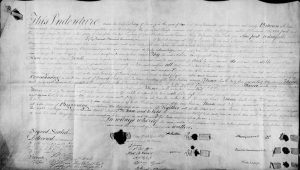The completion Treaty 19 left the Mississaugas with three small reserves at 12 Mile Creek, 16 Mile Creek, and the Credit River. Noting the distress and poverty of the Mississaugas, William Claus, Deputy Superintendent of the Indian Department, met with the Mississaugas and proposed the surrender of their remaining lands.
 Claus promised that the proceeds of the sale would be used to instruct the Mississaugas in the rudiments of the Christian religion and to provide education for their children. In addition, a portion of land consisting of 200 acres located in southeasterly portion of the Credit River Reserve would be set aside as a village site for the Mississaugas.
Claus promised that the proceeds of the sale would be used to instruct the Mississaugas in the rudiments of the Christian religion and to provide education for their children. In addition, a portion of land consisting of 200 acres located in southeasterly portion of the Credit River Reserve would be set aside as a village site for the Mississaugas.
On February 28, 1820 Treaties 22 and 23, referred to as the “Credit Treaties”, were signed and the Crown acquired the reserve lands, which had been set aside in the 1805 agreement.
According to the terms of Treaty 22, the Mississaugas acquiesced to the Crown’s demand for lands at 12 and 16 Mile Creeks along with northern and southern portions of the Credit River Reserve. Treaty 23, negotiated later the same day, involved the central portion of the Credit River Reserve, along with its woods and waters.
Treaties 22 and 23 were signed, once again, by William Claus, Deputy Superintendent General of Indian Affairs on behalf of The Crown, along with Mississauga Chiefs Acheton (Adjutant, Ajetance, “Captain Jim”), Woiqueshequome (Weggishgomin, Okemapenesse, “John Cameron”), Novoiquequah, Paushetaunonquitohe and Wabakagego. The agreements was witnessed by James Givins, Superintendent of Indian Affairs, Alexander McDonell, Assistant Secretary of Indian Affairs, William Gruet, Interpreter for the Indian Department, D. Cameron, N. Coffin, and members of the 68th Regiment.
Ajetance, “Captain Jim”), Woiqueshequome (Weggishgomin, Okemapenesse, “John Cameron”), Novoiquequah, Paushetaunonquitohe and Wabakagego. The agreements was witnessed by James Givins, Superintendent of Indian Affairs, Alexander McDonell, Assistant Secretary of Indian Affairs, William Gruet, Interpreter for the Indian Department, D. Cameron, N. Coffin, and members of the 68th Regiment.
The Credit Indian Reserve lands along the Credit River were retained by The Crown as the Credit Indian Reserve until March of 1846 when the lands were surveyed and put up for auction.



Comments are closed.